This text is being provided in a rough draft format. Communication Access Realtime Translation is provided in order to facilitate communication accessibility and may not be a totally verbatim record of the proceedings.
Click Here to View Supplemental Handouts A
Click Here to View Supplemental Handouts B
>> Amy Hansen: At this time it is very much an honor to introduce Dr. Carol Westby this afternoon. Dr. Westby is currently a consultant for Bilingual Multicultural Services in Albuquerque, New Mexico. She has recently been a visiting Professor at Brigham Young University where she worked with faculty explores assessment and intervention strategies in the area of social emotional development for students with a variety of language impairments. She has received the honors of ASHA and is a frequent presenter at conferences. So welcome Dr. Westby and thank you so much for sharing your expertise with us today.
>> Dr. Carol Westby: Thank you Amy, and I'm certainly honored to present this seminar in remembrance of Nancy McKinley. She was extremely supportive and did so much for our profession. Today we're going to be talking about three aspects of making inferences. First, we're going to look at what inferences are and then we're going to look at a little bit of the literature about what we know regarding how students with language impairments make inferences and then we'll look at some strategies that facilitate a student's ability to make inferences. You have a lot more slides and a lot more material on the slides than I'm going to cover today so as we go through I might occasionally skip a slide or not cover everything that is on it. But I felt that since you have access to downloading them, you can then go back to the slides and look at them for more detail on what we talked about.
Types of Literacy
Now, when we look at what is involved in literacy and comprehending what you read, there can be three types of literacy.
- There is basic literacy that is just reading the words on the page. And certainly many students who are on the autism spectrum disorders continuum can do this quite well.
- Critical literacy, however, requires reading between the lines. You have to analyze and internalize and interpret, synthesize, explain. For that you have to be able to make inferences.
- Dynamic literacy involves making inferences across multiple different texts that you're reading - seeing the relationships among those texts.
Now, we expect children even in elementary school to engage in that critical and dynamic literacy.
For example, this passage comes from one of the old national assessment educational process exams for fourth graders and in this story the students were reading about spider and turtle.
Spider invites Turtle to come to lunch. Spider lives on top of a high hill. Turtle crawls all the way up to the top of the hill and Spider looks at him and says, "Your feet are filthy. Go wash your feet down in the creek." So Turtle goes down and washes his feet. By the time he gets back up again his feet are dirty. He does this a couple of times. Spider ends up eating all the food. A few days go by. Turtle invites Spider to come to lunch. He says to Spider, "You have to eat with me at the bottom of the creek." Spider jumps on to the surface of the water but he is too light to break the surface tension. So he puts on a jacket, puts rocks in his jacket, sinks down to the bottom of the creek and Turtle says, "Oh, it's most impolite to eat in my house with your jacket on. Take your jacket off." And as soon as he does he pops back up to the surface of the water.
Well, here are some of the questions, and you realize that for these questions basic literacy would not be sufficient. The first question requires critical literacy:
When Turtle remains quiet about his mistreatment by Spider the author wants you to:
- believe Turtle is afraid
- have sympathy for turtle
- feel dislike for turtle
- think turtle deserve no dinner
Nothing that you would have read would have given you that answer.
The next question requires dynamic literacy. It requires pulling in other information you have.
Spider's behavior during the first part of the story is most like that of:
- mother's protecting their children
- thieves robbing banks
- runners running races
- people not sharing their wealth
In order to make the inferences for that critical and dynamic literacy students have to build mental models within their head and they have to be able to build mental pictures of that text.
Comprehension Requirements
Here is an example of a little boy who learned how to do that. Tomas Rivera became the Chancellor of the University of California at Riverside, the highest position within University of California systems. As a young child he loved hearing stories and one evening his grandfather said he had run out of stories. "Go into the library. I bet you can find some more stories." Tomas was fortunate because in that community they were very interested in him and that summer the librarian worked with him. One day when the library was busy Tomas read to himself. He looked at the pictures for a long time. He imagined he smelled the smoke at the Indian camp and rode a horse across the hot dusty desert and in the evening he would read the stories to Mama, Papa, and Enrique. He learned to build the models.
In order to build the models you have to have an understanding of the text microstructures. You have to know the meanings of the words and you have to comprehend the sentences. You have to understand the cohesive devices, how pronouns relate to nouns, the connective words that hang the sentences together. You have to have an understanding of the text's macro structures - what the text is about, the theme or the gist and how they're organized. That, however, isn't sufficient. You have to bring in your past knowledge and experiences and link it with your text micro and macrostructure understanding. And then you have to do that for multiple texts that you read.
Image 1. Mental Modeling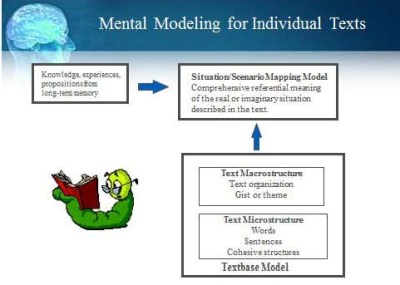
We're now expecting that even by mid elementary school, children can compare and contrast across multiple text.
Image 2. Situation Models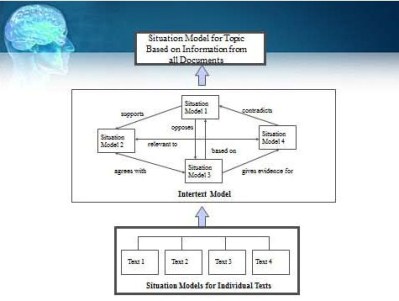
(Please refer to Supplemental Handouts B; page 2 for larger view of Image 2.)
Certainly, many of the students we have don't do that well and certainly students on the ASD continuum have difficulty building those mental models and making links across different parts of the text using those linguistic devices that signal mental cohesion - the pronouns and connectives. Most of them are very poor working memory skills which is the ability to hold several things in mind and manipulate them simultaneously. They're poor at metacognition and don't notice if there is an inconsistency in the text. Often they're not aware whether they're comprehending it or not. Even if they are aware, they're not sure what to do about it.
What is an Inference?
An inference is bringing information from the text or picture and your previous knowledge combine to build this inference.
Image 3. Example of an Inference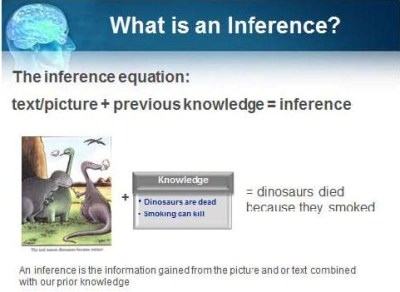
You're seeing the dinosaurs and it says "the real reason dinosaurs became extinct" and you take your knowledge that smoking is bad and dinosaurs are extinct to make the inference that dinosaurs died because they smoked. Many of our students function at a very literal level.
In the below example, Batman and Robin are looking at the "Help Wanted" sign and they say "Oh no, somebody is in trouble." That might be the more literal kind of interpretation. What they have to do here is realize this is a sign on a store and they have to take into account that most likely it is a sign for someone seeking to employ someone. Realize how much inferencing has to go on with that cartoon.
Image 4. Example A: Literal vs. Inferential Comprehension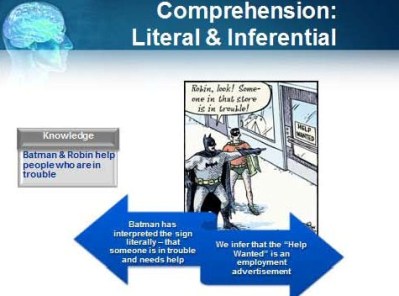
In the next example, you have to realize these are colonists and they have dumped tea into the harbor. These are probably the Bostonians dumping the tea into Boston Harbor and they're talking about Mr. Starbucks because Starbucks' sells primarily coffee and he might be happy to get rid of tea.
Image 5. Example B: Literal vs. Inferential Comprehension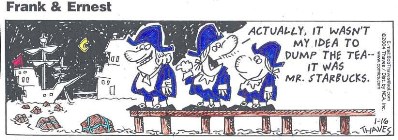
So Batman and Robin are looking at the "Help Wanted" sign and they say "Oh no, somebody is in trouble." That might be the more literal kind of interpretation. What they have to do here is realize this is a sign on a store and they have to take into account that most likely it is a sign for someone seeking to employ someone. Realize how much inferencing has to go on with that cartoon.
Good readers make a lot of inferences. They connect what is happening in the text to their own knowledge. They see the relationships between nouns and pronouns. They figure out meanings to the words of the text. They figure out how to explain what is happening. They notice the character's personalities. They understand how the characters related to one another.
Image 6. Model of What Good Readers do When They Inference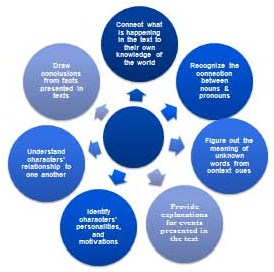
Click Here to View Larger Version of Image 6
Reasons for Inferencing Difficulties
Oakhill and Yuill (1996) say these students may not have the necessary background and knowledge. They have knowledge but they don't know how to access it while they're reading the text. Again, many of our students that have language impairments just have a hard time synthesizing information from the different parts of the text and some of our students aren't even aware that they should make some inferences. They figure if it is not written in the text then there is no possible answer.
Skills Needed to Make Inferences
In a recent study, Karasinki and Weismer (2010) looked at students with typical language and children with a variety of language and learning problems and they said in order to make inferences you clearly have to be able to:
- Comprehend the linguistic input.
- Have general world knowledge. I'm also going to add that you have to have good Theory of Mind, particularly with narratives because you have to make inferences about the characters.
- Have really good working memory - searching your memory and keeping the text in mind as you are doing this.
You have to have that background knowledge and you have to be able to retrieve it. This comes out of a classic study that shows how difficult it is to comprehend something if you don't have the knowledge or someone has not given you the gist of a situation:
The procedure is quite simple. First you arrange items into different groups. Of course one pile may be sufficient depending on how much there is to do. If you have to go somewhere else due to lack of facilities that is the next step; otherwise, you are pretty well set. It is important not to overdo things. That is, it is better to do too few things at once than too many. In the short run this may y y not seem important but complications can easily arise.
As I'm reading that most of you don't have a clue what this is talking about. If, however, I give you the title that it is about washing clothes and you've had experiences washing clothes, then you can make some sense out of it.
Inference Examples and Classes of Inference
Now, there are a variety of kinds of inferences students have to make. I'm going to give you some examples based on two books that we have used with students in social skills group. Holes was the 1999 Newberry award book and it is about Stanley and his wrongful conviction. He was found guilty and was sent to a juvenile detention camp in west Texas where he digs holes searching for a treasure that the warden is sure is hidden someplace in the desert. The other book, Hugo Cabret, is a historical novel about a little boy in the 1930s who is living in the Paris train station.
When reading both of these books, you have to be able to do the following types of inferencing:
- You have to be able to make an anaphoric reference which is figuring out who the nouns and pronouns refer to.
Example: In Holes, the female warden scratched Mr. Sir, the guard. She was furious with him. - You have to be able to make bridge inferences by looking at something that you're presently reading and thinking about how it relates to something that happened earlier in the story.
Example: In Holes, Stanley and Zero are covered with yellow spotted lizards. Those lizards are very vicious; one bite and you're dead. But the lizards aren't biting them. You have to think "Hm, Stanley and Zero just recently ate a bunch of onions. Quite a few chapters back there were some men in Greenlake who were going to go hunting and they were afraid of the lizards and Sam sold them onion juice. Maybe there is some connection with lizards not biting you and eating onions." - Make causal explanations.
Example: Stanley's family has been cursed because his great grandfather was supposed to carry Madame Zaroni up the mountain to let her drink from a spring of water. He didn't do that. Because of that, the family is forever cursed. Near the end of Holes, Stanley carries his friend Zero up the mountain and finds water for him and saves him. It never tells you how that's related to how Stanley's family comes into good fortune. You have to make the inference that Stanley's doing this for Zero broke the curse. - You make predictive inferences. What is going to happen?
Example: In the invention of Hugo Cabret, Hugo is stealing from the old man who is the toy shopkeeper. Are you going to predict they're going to be enemies or predict that they might become friends? You have to make inferences about the character's goal. Why is Hugo stealing these toys? - You have to make elaborative inferences.
Example: In Holes, the Warden lets you know she put rattlesnake poison into her nail polish. She paints her nails and then she gets very angry at Mr. Sir and she scratches him. Now, a scratch shouldn't be that big of a deal but Mr. Sir is screaming and carrying on and for days. Afterwards his whole face is all purple. You have to realize that the rattlesnake venom probably caused that severe reaction.
That is some of what is involved in making inferences.
Language Impairment and Inferencing Research
Well, what do we know about students with language impairment and making inferences? Oakhill and Yuill (1996) were one of the first to look at that. They looked at readers that were good decoders and some were good comprehenders and some were not so good comprehenders. Even when they left the text in front of them, you see that the poorer comprehenders even made a lot of errors on literal comprehension as well as many, many errors if they had to make inferences.
Table 1. Percentage of Errors on Literal & Inferential Questions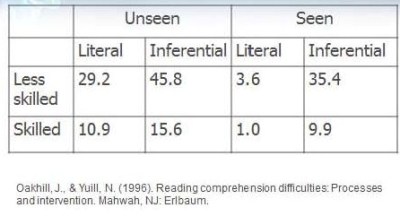
More recently Laing and Kamhi (2002) had third graders do "Think Aloud" as they read. You are talking about how you are making sense as you're reading. They noticed that the below average readers gave far fewer explanations. They would try to make some inferences but they gave very few inferences that explain things.
Table 2. Types of Inferential Statements by Average and Below Average 3rd Grade Readers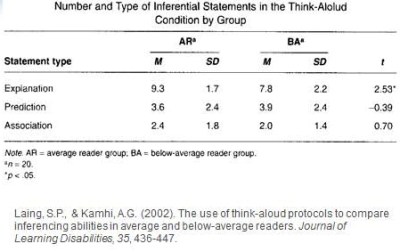
Very recently, Adams Clarke and Haynes (2009) asked could we use a child's abilities to make inferences to differentiate between children with typical language and children with language impairment. Then, within the children with language impairment group is there a difference between children with specific language impairment - those youngsters who primarily have difficulty with semantics and syntax - compared to those youngsters that have difficulty primarily in the pragmatic area.
They assessed all of the children's comprehension of sentences. They matched them on sentence comprehension. They then showed them a picture of a burglary. The children had a number of clues. They read them a little story about this picture. Then they asked them a number of questions that required making inferences. These questions from previous research had shown to be in a hierarchy from the easiest types of inferences to the more difficult kinds of inferences:
- Why was the dog barking?
- Why is the policewoman there?
- What happened when the burglar got into the house?
- What clues will the police find about who broke in? (prompt allowed)
- Why did the burglar break into the back of the house?
- How does the family feel now? (prompt allowed)
- How do we know it was the burglar who broke the window?
- Why do you think the burglar took only the watch?
- Why would someone steal something? (prompt allowed)
- What will the family do now because of the burglary? (prompt allowed)
- Should all theft be treated in the same way? (prompt allowed)
They then looked at what kinds of responses did the students give:
- Did they misinterpret something literal? (e.g., the child is asked, "Why do you think the burglar took only the watch?" and responds, "cos he creeped in.) The child is probably not processing some of the literal information.
- Was it a wrong inference? (e.g., when asked "How does the family feel now?" the child responds, "feel better if go to hospital.") It is not matching up.
- Immature inference. Some children made an inference but it was based on their own personal experience.
- Odd inferences. This is often what you might expect with kids with pragmatic disorders. (e.g. when asked "Why was the dog barking?" the child responds, "He was telling the truth."
- Because. Some students just said "because".
- Scope. Some students kind of started giving right information but didn't go far enough.
- No Response. Some kids just didn't say much at all.
Well, not surprisingly all of the students that had language impairments had much more difficulty than matched age peers in making inferences and they had even significantly more literal comprehension errors even when they were matched on sentence comprehension. That is interesting. The children with language impairment, even when they were matched in terms of their ability to comprehend individual sentences, still made more errors in both literal comprehension and inferencing comprehension.
The students with specific language impairment did better on sentence comprehension than children with pragmatic impairments but they still had equal difficulty in making inferences. Surprisingly on this, the children with pragmatic impairment didn't make more odd or wrong inferences. This was a little bit unexpected but the researchers said it might have been because they were matching children on sentence comprehension. Many of the youngsters we see with ASD have difficulty even at that sentence level.
Skills Needed to Make Inferences
Now again we saw that Karasinski and Weismer (2010) said here are the skills you need for making wise inferences:
- Comprehension of linguistic input - Vocabulary; Syntax
- General world knowledge - Including theory of mind (ToM);
- Working memory
They looked at a number of students who had been followed for quite a few years in Iowa. They now looked at them at 8th grade. The normal language users had skills in all of those areas so they had general knowledge and working memory. The students with specific language impairment had deficits in working memory and language but normal cognitive skills. The students with nonspecific language impairment had deficits in all three areas. The students with low cognition had normal language skills with working memory a little bit lower than the neurotypical children but not as poor as the children with language impairments.
Then they look at the students' abilities to make near and far inferences. A near inference is where in the text when you ask the question that required an inference, the information to make that inference was right next to what you were asking the question about. The far inferences meant that you had to hold information in your memory that occurred earlier in the text. Well, the researchers' work showed (and they looked at a number of assessments of working memory) many of them were very high with working inferences. If you cannot hold several things in mind and manipulate it you don't do well in making inferences. The typical students and the students just with low cognition showed no difference in making inferences. The typically language disordered group did much better even on adjacent inferences than any of the students with language impairments. All of the groups had a lot more difficulty when there was a distance between where the information was presented in the text and when you had to make the inference.
The students with language impairment had considerably more difficulty and there wasn't a difference between the students with specific language impairment and the students with nonspecific. They all had marked difficulty - much more difficulty than even the students with just low cognition.
Making Inferences
Here are a number of the skills that you're going to need to make inferences. If you're going to need those skills, then what is our job going to be?
- We're going to have to help students develop vocabulary.
- We're going to have to help them develop Theory of Mind.
- Now people might say if working memory is an issue should we help them develop that?
- What we have to do is provide support, for example, visual supports to help the working memory.
- Teach them how to question clearly help activate prior knowledge and teach them how to summarize.
These are some of the things that we're going to look at in our last half hour.
Vocabulary and Reading
A lot of research shows that you really have to have good vocabulary. Vocabulary in the early grades correlates very highly with reading by high school. Now, you can teach students to make some use of context; although context often doesn't give you all the information or sufficient information.
Below are a couple of examples of how you might be able to figure out what a word is given the context:
- Murderers are usually incarcerated for longer periods of time than robbers.
- Ben is fearless, but his brother is timorous.
- Dad gave credence to my story, but Mom's reaction was one of total disbelief.
- When we invite the Paulsons for dinner, they never invite us to their home for a meal; however, when we have the Browns to dinner, they always reciprocate.
Take for example, "Ben is fearless (the child might know that means he doesn't have fear); but his brother is timorous." The child might never have heard the word 'timorous'. If he understands that but is contrasting with fearless it must mean "Ben doesn't have any fear but his brother must have fear!"
Lots of teachers send children to the dictionary. The problem with that is dictionaries don't give good definitions. Often you look at the definition and you say, "I don't understand any more than I did before I looked at this." So it is important that we provide students with user friendly definitions.
Table 3. Teaching Vocabulary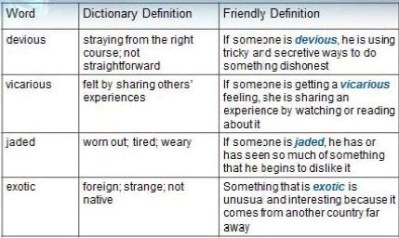
So, for example, the word 'devious', the dictionary says "straying from the right course; not straightforward". How does this apply to "His uncle was devious?" If you give a definition that someone is devious he's using tricky and secretive ways of doing something that is dishonest. That is a helpful definition. If you just have students try using dictionary definitions you get some very strange responses: "He was devious on his bike." Well, that is not going straightforward.
Below is my favorite dictionary ever:
Image 7. Collins Cobuild Language Dictionary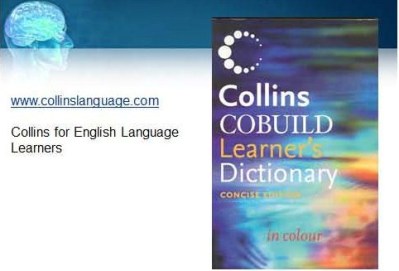
This is useful from mid-elementary probably through high school and there is also an advanced version for high school and college. It provides user friendly definitions. The definitions are put in sentences and it gives you sentences for all the different meanings of the words. For example, the word 'top' in this dictionary has 33 different definitions. Here are just a few of them that are shown.
Image 8. Definitions of "Top"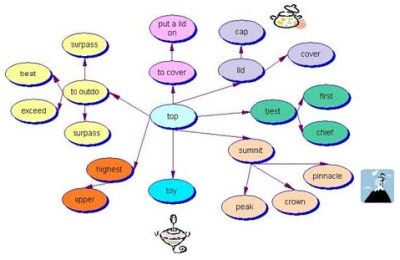
Below is a useful tool. It can be something useful to give to upper elementary school teachers or to use with middle school students with language impairments. It teaches multiple meanings of words. We've taken the principles that come out of that material and used them. So here is an example that we've used with Holes, with our boys:
Image 9. Multiple Meaning Words: Innocent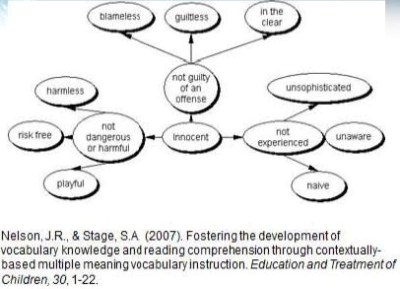
The word 'innocent' can have different meanings. It can mean 'not guilty' and not guilty can have several synonyms. It can mean 'not experienced'. That could have several synonyms. It could mean 'not dangerous' or 'harmful' and that could have several synonyms. If we look at the story of Holes we can use all those meanings of innocent.
- Not guilty: Stanley wasn't guilty of the robbery.
- He was 'blameless': The court did not find him guiltless.
- We can use innocent in the terms of 'not experienced': Stanley was innocent about the functioning of the court. He was naive about how the court functioned.
- We can use it in terms of not harmless; not dangerous or harmful: The yellow spotted lizards are not innocent. They are really quite harmful.
Then we can have students kind of match those different meanings with how they're used in the text. Which example would mean 'not experienced' - Stanley was a really good kid. He was too innocent.
Evaluating Vocabulary Knowledge
We want to make students aware of their own knowledge of words and Lubliner (2005) described this below:
Image 10. Evaluating Vocabulary Knowledge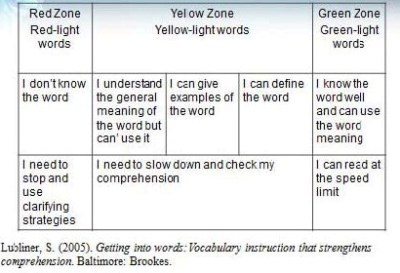
Stoplight Vocabulary
So, if it is a word I know then it is a 'green-light word' and I know its meaning. Some are 'yellow-light words' and I know a little bit about it but not exactly sure what it means. You can take the vocabulary words and ask the students to mark the words as to 'green-light', 'red-light' or 'yellow-light words'. (see image below)
Image 11. Stoplight Vocabulary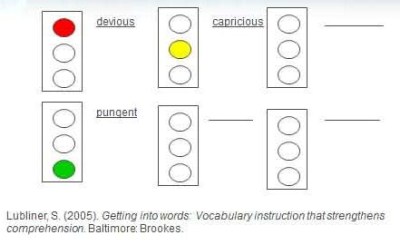
We know a lot of research shows that children with language impairments, in particular, students on the ASD continuum have a lot of difficulty with inferences about figurative language. Often we just give them the explicit meaning of the figurative language. Below we gave them the explanation so in the book, "The Invention of Hugo Cabret", Hugo has been trying to fix this automaton. He cannot figure out what to do. The book says, "Suddenly it was as if the light went on in his head." Well, that means that now he knew what he had to do. Well, why didn't the author just say, "Hugo now knows what he has to do to fix the automaton." Given the explanation, what happens if we're in a dark room? You can't see very much. If you turn the light on now you can see something. Well for Hugo it was like he was in the dark room. I mean he couldn't even see to fix the automaton. But now if he turned on the light oh he could see what was broken. That was kind of like in his head. That was the light that came on and he could see what he had to do.
Image 12. Language in the Context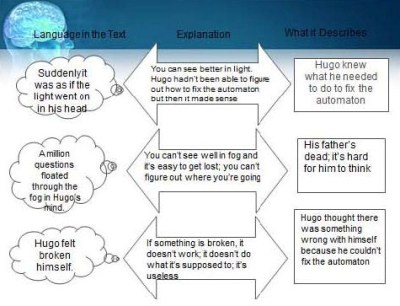
Theory of Mind
Particularly for narratives students have to have Theory of Mind. You have to realize that other characters, everyone, have beliefs and ideas and knowledge and desires and those ideas, knowledge, beliefs and values might be different than your own. You need to be able to predict based upon what people in those texts might do based upon what you know about them.
Requirements for Theory of Mind
To have Theory of Mind you have to:
- Read the affect cues.
- Have emotional labels.
- Have social cognition.
How are people expected to feel and react in certain situations? The research shows that having higher levels of syntax can help you make these kinds of inferences and understand Theory of Mind. So it was noted that students can hear and see James asking, "Where is the dog?". If they can comprehend that kind of sentence that has a noun complement - 'where is the dog hiding? - then if you say, "James knew" - well, they cannot see James knowing something but it does have the same structure of James asked. James knew where the dog was hiding. For students with Asperger's Syndrome this can give them insight - help them develop an awareness that things go on in people's heads.
Inferencing Emotions in Situations
As we noted many students with any type of language impairment are poor at making inferences. Ford and Milosky (2003) show that children with language impairment are poor at making emotional inferences. Below, kindergarten children were shown facial expressions and even the children with language impairment were 100% successful in identifying happy, sad and mad. But they couldn't use that information when they were given a situation such as "Twinkie was bouncing a ball. A bully took the ball. Twinkie was...?" The child was asked to point to the picture of mad or angry and the children with language impairments were as likely to point to the happy picture as they were the sad.
Emotions and Computer Programs
Now, there are some computer programs that can be useful in teaching this. Let's face it!, are free programs that you can download that are for kindergarten up through adolescence and it gives students practice in recognizing different expressions and matching them up.
Image 13. Example of Computer Programs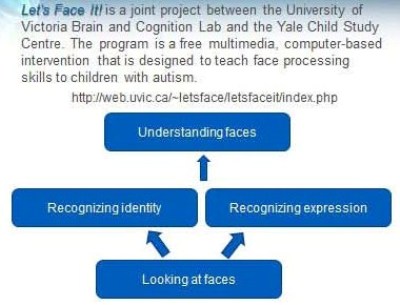
Mind Reading is another compute program. It teaches 420 different emotional words with multiple types of each of these. So for angry there can be different degrees and other words that referred to angry along with other words that referred to sad. The program could be useful in teaching these words anywhere from kindergarten up through adults.
We've also done activities that we call "Using the Emotional Thermometer" with students from mid elementary and up. We say "Okay, you can't just use the word 'happy'. What if someone is just a teeny, tiny bit happy? What if it is the happiest you have ever been?" We teach variations of the different emotions.
Image 14. The Emotional Thermometer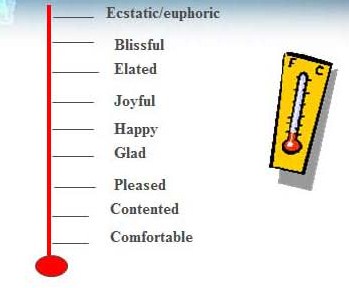
Theory of Mind in Children's Books
Books for preschool children contain many references to mental states.
- In 317 preschool books, 78% referred to internal states.
- 34% contained a false belief.
- 31% contained deception.
Connective Words and Development
It is helpful to teach students about connective words. Again, these were examples that came from our social skills group. We would first start teaching these connective words with personal experiences because this is going to be easier for them to understand. "My brother had to go to summer school because he failed English." Well, what happened first was he failed. What happened second was he had to go to summer school. Since you've experienced this you can understand it.
A little more difficult to understand is, "Zero dug Stanley's holes because Stanley was teaching him to read." You have to realize what happened first - Stanley started teaching Zero to read and then Zero was grateful so Zero dug Stanley's holes.
We would connect these words first in personal experiences and then in narrative and then in expository text.
In the following video, a 12 year old with Asperger's Syndrome and he's learning how to use these types of connective words:
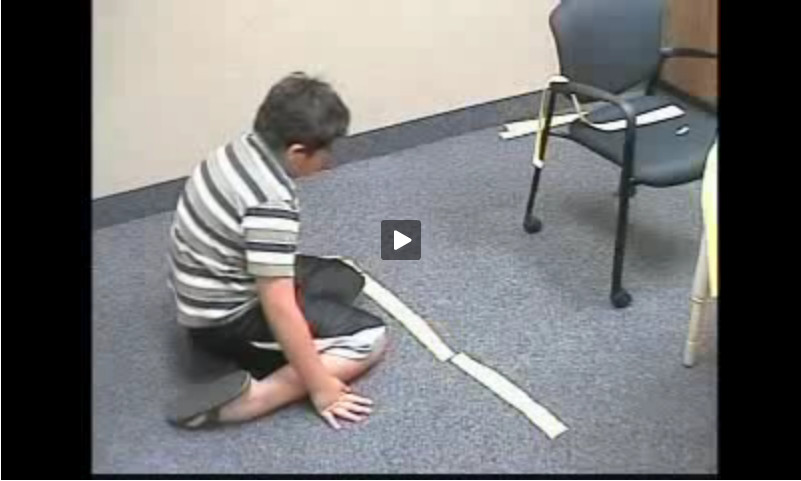
If you cut the sentences that are more difficult, what kind of connectives would you put in? A 16 year old boy in our social skills group is doing the same task on computer because the computer was more motivating. His primary diagnosis was ADHD. You can kind of see some of that happening here.
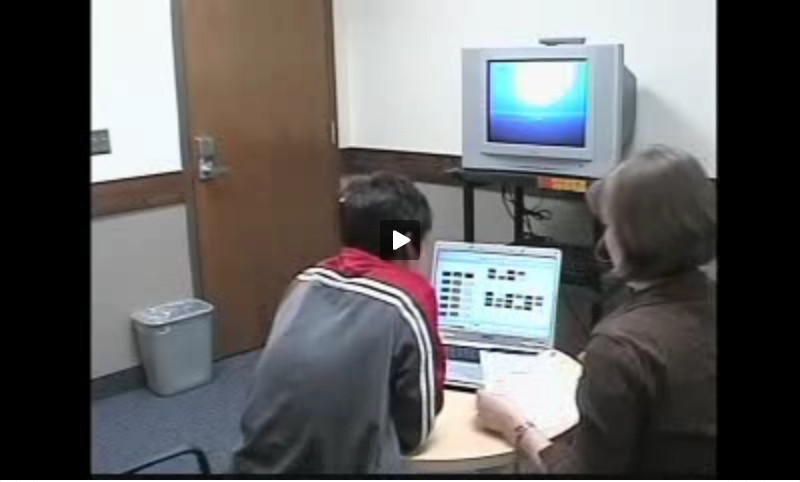
Strategies to Build Inferential Comprehension
Think Aloud
So far we've covered teaching vocabulary and teaching the connective words. Using "Think Aloud" strategies have been shown to really help with reader comprehension. With think aloud teachers first model that:
- You look at what you're going to read.
- You make predictions. From the title, "Mr. Gumpy's Outing", an outing is going someplace. I bet he's going someplace.
- You think through and you make those mental pictures in your head. So if you're reading, "It was over there, while my father and mother and I were driving just north of Oslo, that our car went off the road and tumbled down a rocky ravine." You say I have this picture in my head and this is what it looked like. You describe the picture that you have in your head. You make connections with prior information in the text.
Now, in the book, Witches, the little boy asks his grandmother, "How would I know if I recognize the witch?" One of the things Grandma says is, "Tthey always wear gloves to hide their claws." So one day the little boy is outside and this woman comes up and wants to talk with him. He notices she had on gloves. He's making that connection - "Oh, the author told us that witches wear gloves."
Fix Up Strategies
The following image demonstrates fix up strategies. "I'm not sure I understand this here. I better reread it." Then follow this up with encouragement to continue this line of reasoning.
Image 15. Example of Fix Up Strategies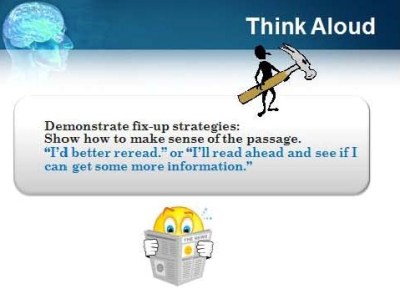
Laing and Kamhi (2002) used this with third graders who were average readers and below average readers and found that the think-aloud strategy helped and improved both of them to answer literal and inferential questions and it turned out that it helped the average readers even more than the below average readers.
Image 16. Comparison Results of Average Readers to Below-Average Readers Using Think-Aloud Protocols for Inferencing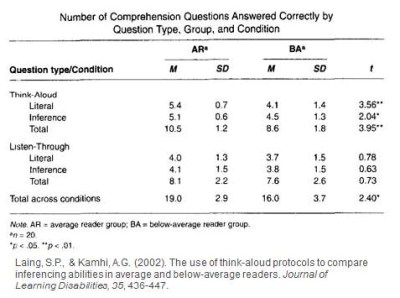
Qualitative Reading Inventory
I like using the Qualitative Reading Inventory (Leslie & Caldwell, 2011) because it has reading passages from pre-primer up through high school and for each passage it has explicit questions and implicit questions and it gives you suggestions for Think-Aloud and how to score the Think-Aloud.
These are statements that the student might make as they're thinking aloud. What happens with Think-Aloud is you have them read. You put a little mark at a place where you say "okay, when you see the little carrot I want you to stop and tell me what you're thinking about." These are things that the students might say that let you know that they're comprehending:
- Restatement, paraphrasing, or summarizing of what the author has said, preserving the language of the author or gist of the author's ideas.
- Making new meaning: makes an inference, draws a conclusion, or engages in reasoning.
- Questioning that indicates understanding: asks a question based on understanding of the text, e.g., questioning the motivation of a character, applying text content to a similar situation, or projecting text content into a future point in time
- Noting understanding: student recognizes that she or he understands what was read.
- Reporting prior knowledge: student reports a match with what was previously known or indicates that prior knowledge was absent or in conflict with the text.
- Identifying personally: relates the text to personal experiences, makes a judgment of some sort on the basis of personal experiences, states interest or lack of it, or indicates like or dislike for a topic.
Here are things they might say that indicate they're not comprehending:
- Questioning content: asks questions about character motivation or the applications of a concept that indicate lack of understanding. The student also asks about the meaning of words or concepts.
- Noting lack of understanding: clearly states that she or he is confused about something.
Weirs gives you a checklist (see below) so that as you listen to them do the Think-Aloud, you can note the kinds of strategies that they're using or not using and give you some ideas of other strategies to teach them when they're thinking aloud.
Image 17. Think Aloud Checklist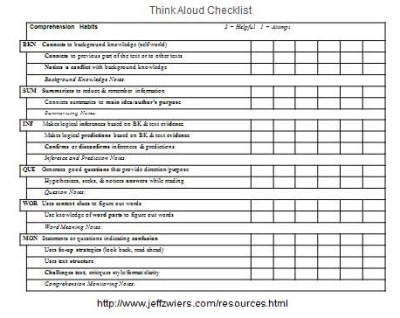
Please refer to Supplemental Handouts - page 3 for larger version of Checklist.
I also use the Qualitative Reading Inventory to look at the kinds of errors the students make in advancing the questions. Have they failed to make an inference across the passage? Have they not understood something causal? Has there been something maybe in the sentence? Have they over relied on personal information? And the Weirs gives us this kind of checklist. What you do is for each of the questions and the qualitative reading inventory you write them down:
- You indicate whether it was an implicit or explicit and correct or incorrect and then you look at the question and say did you have to make a relational inference?
- Was it causal?
- Was it from the text it was not from prior knowledge?
- Was it from misinformation?
I found this really useful in understanding the nature of the comprehension problems that the students are experiencing.
Below are some more strategies to teach inferencing. Many students are not aware of the difference between a fact and an opinion. So we'll start out and look at the picture below:
Image 18. Strategies to Teach Inferencing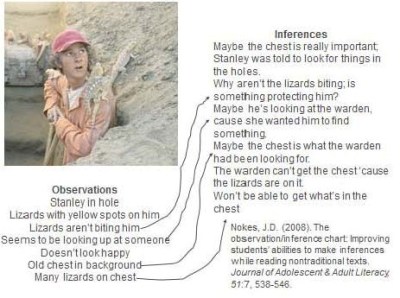
Describe what you're seeing in the picture. It must be what you see. Some of our students when they first started they would give us: "Stanley, holes, lizard, chest". We said, "No. You have to give me a sentence about this such as, 'Stanley's in the hole.', 'There are lizards with yellow spots on him.', 'The lizards aren't biting.'" So they have to give the descriptive observations. Then let's make some inferences. So descriptive observation might be that he seems to be looking up and inferences may be that he's looking at the warden. So you make a connection between the observation and the inferences. With older students you can even do that with video clips. In doing a Civil Rights unit and showing them the I Have a Dream speech, many students with language impairments like we've had in our group don't know how to appropriately interpret videos that they have seen. So they watch the video and again like with the picture out of Holes they make observations, they make inferences such as, "I think it is Washington, D.C." Well, why? Well, I have seen those buildings in other pictures. Below is a rubric that you can use to evaluate how good their observations are.
Image 19. Observation/Inference Rubric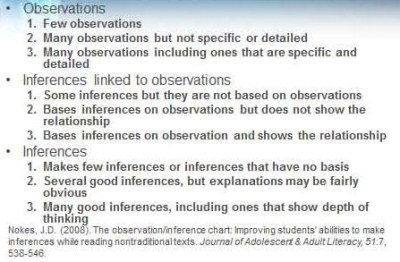
So with our boys initially they would start with very few observations. You want the observations to be more detailed and specific and you want the inferences to be able to be explanatory.
The question/answer relationship strategy has also been shown to be real helpful in teaching kids that you have to make inferences.
Image 20. Question-Answer Relationships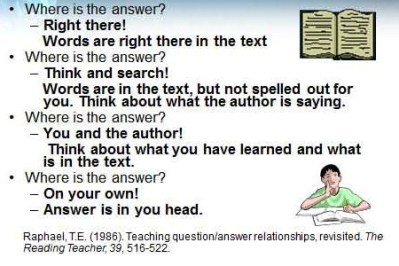
Again, so many of the students we see on the autism spectrum even get upset when you're asking them a question and the answer is not there. I've had kids say, "Well it doesn't tell me." What do you expect? This is where we teach them that sometimes the answer is right there in the book. Sometimes it's there but we're going to have to look across a couple of pictures. Sometimes it is between you and the author. What is in the book and things that you have to think about in your head? That is inferencing. And sometimes it is your own personal knowledge.
Here is an example of this from the book Passage to Freedom. Sugihara was the Japanese ambassador and the Jews were fleeing to Poland and they came to him asking him to write visas so they could get out of the country. Right there the question was why is the family in Lithuania? Now "why" questions are difficult but the answer is right there. It says he was the ambassador. It was his job to fulfill the mandates of the Japanese government while he was there. Think and search. How did Hiroki's life, his little boy, change after the Jews came to his house? Well, you have to go across a couple of pages. First he couldn't go out to play because there were people out there. Then they started getting short of food. Why didn't Mrs. Sugihara help write the visas? Never tells you. You have to figure that he was going to be in trouble. He was told not to write the visas and yet he wrote them anyway. Probably he didn't have his wife help him because he didn't want to get her in trouble. And then can you think of other persons who have risked their own lives? That is all on your own.
Image 21. Passage to Freedom - Question-Answer-Response (QAR)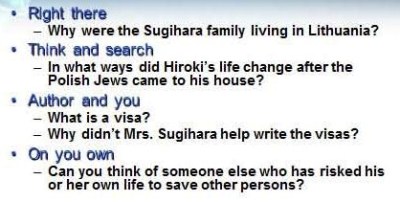
Also getting them aware and this is particularly true with students on the continuum. Different characters in the story have different feelings. So you put down the events in the story and how the different characters felt. For example, when Mr. Sugihara decides he's going to write the visas, the Jews are thrilled. Now, is Mr. Sugihara thrilled? No. At this point he's really scared and worried because he now knows he's putting his own family in danger. So helping the students realize the different characters can have quite different feelings over the same event. Many of our students have a lot of difficulty making inferences about characters because they focus on what is happening not why. They think the characters are acting like they do or they don't consider the whole story or they only consider one story, one character in the story.
Let's take some examples from the Tale of Desperaux. He was the only child to survive. It is another Newberry book and read frequently in elementary schools. Helping students focus on why something happened. Despereaux was found reading in the library and his brothers decide they're going to throw him into the dungeon. Why do they do this? You have to realize they're afraid that people in the castle will find him, once they find one mouse they know there are other mice and they'll all be at risk so you have to understand how they're feeling and how Despereax is feeling. Not focusing on the act of being thrown into the dungeon but why. Some of the folks thought it would be cool to be thrown in a dungeon and you say yeah but he's a tiny little mouse. What is in that dungeon? There are big rats that could eat a mouse. Now, you would be bigger than the rat. You might not be afraid of the dungeon. But Despereaux has reasons to be afraid. Sometimes they don't consider the whole story.
Image 22. Coping with Inferencing Difficulties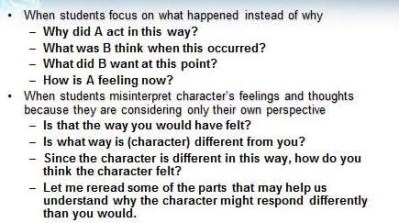
There is a story, a little girl who is a servant at the castle. She wants to be the Princess. Through a lot of the story she's plotting how to kill the Princess. But eventually the Princess does something very kind to Magrie now Magrie no longer wants to hurt her because it is the first time that anyone has been kind to Magrie. You have to realize now that she has changed. Then you have to always realize how all of the different characters are feeling.
Approaches to Treatment
Now, because of time we're going to have to skip some of these things. I always tend to have more than I can cover. I do want to mention this concept of reciprocal teaching. This idea has been around you can see for close to 30 years. And I knew about it but I found that most of the students I see with any kind of language impairment just can't do all of those things. Because the teacher is just a model as she's reading how to predict, how to ask yourself questions, how to clarify, how to summarize. And so she does that.
Reciprocal Teaching at work is a new book that just came out a couple of months ago that we love and are using it with a lot of our middle school students. It takes you through each of these steps and gives you ideas for how to work with students who have difficulty in each of these categories. So it gives you ideas of what to model as you're using each of these steps. And gives you this little door chart that this folds over.
So as you're working with the students you say okay let's first make a prediction. You have them write the prediction down. Let's kind of ask a question. Let's clarify. There is some part of this we're not understanding. Let's write a little summary. Again, she lists kinds of problems that students can have and things that you can do to help them in each of those areas.
Again, the activities in this book would be meant for certainly our higher functioning students, students with Asperger who are able to read, have good decoding skills but comprehension problems.
The below little spinner is a great idea because you can work with groups of students and as we're reading, the students can spin and we say okay you spun. Clarify. You have to clarify something in this paragraph we just read. If the student summarizes, summarize the paragraph we just read.
Image 23. Activity Example from Reciprocal Teaching at work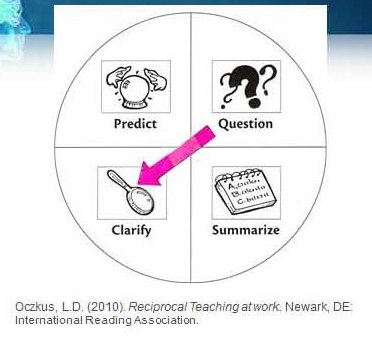
Inferencing helps to stretch your mind. Once your mind is stretched by a new idea it never regains those original dimensions.
So this has been a real quick introduction to issues related to inferencing with students who have language impairments and particularly those on the ASD continuum. Thank you.
[Applause]
>> Amy Hansen: Thank you so much, Dr. Westby. At this time if anybody has any questions they would like to ask please feel free to type those in. We'll give you a couple of seconds. While people type in any questions that they may have, I would like to ask if you could explain poor metacognitive skills. What do you mean by that?
>> Dr. Carol Westby: Metacognitive skills is knowing what you know and don't know. It is an awareness of your own knowledge. This tends to be quite deficit in most kids with language impairments, particularly those youngster with autism because it is an aspect of Theory of Mind. There are two aspects of Theory of Mind. There is knowing that other people have thoughts and ideas and figuring out how they act on them. That is interpersonal. Then there is intrapersonal Theory of Mind being able to reflect on your own thoughts and feelings. And students on the ASD continuum have quite a bit of difficulty in both areas. So often are students with ASD are not aware whether they're understanding or not understanding, whether they have the information to do something or not do something.
>> Amy Hansen: Okay. Great. Thank you so much. Can you explain what an object compliment is in a sentence?
>> Dr. Carol Westby: An object complement is a whole none phrase, kind of like a little sentence of itself that is the object of a verb. In an example such as James asked. Well, what did he ask? Normally then we would have an object of the sentence. If I had the dog chases the cat, cat is the object of chase. If I had James asked, I have a whole sentence that is that complements, functions as the object of that verb. James asks, where is the dog hiding? When we talk about a noun complement we're thinking about a whole sentence that is functioning like a noun/object would be. Is that making sense?
>> Amy Hansen: That does make sense. Thank you.
>> Dr. Carol Westby: It is a more complex structure and we have found delays in children with ASD and understanding that but once they can understand that, then it has made it easier to teach them explicitly about Theory of Mind. They don't get good at Theory of Mind. It is kind of like temple grandin she can talk about like someone has told her this is how someone feels in this situation. She now has some understanding of it intellectually that enables her to behave more appropriately.
>> Amy Hansen: I see. That makes a lot of sense. That is a great explanation. All right. I see a question has come in, "Do you have any ideas for teaching a child to monitor their own understanding?"
>> Dr. Carol Westby: Thinking back one of the things that helped with this was sometimes getting kids and particularly if you're working within a group talking about what makes sense and what doesn't make sense and having some kids who can say oh yeah it makes sense. Here is why it makes sense. Again, you have to be careful with this. We had one youngster who would often kind of come up with irrelevant responses and again the kids had gotten used to part of how we would start this is how we started the teacher would sometimes give stupid responses. Maybe I shouldn't say it that way. It is responses that just did not make sense. So much so that the kids realized that this is really strange. At first it was funny when the teacher would do this. The kids were not sure what to do about it. It was really the teacher. And we would say you know what sometimes she just gets it wrong. We would get them used to sometimes you have to really listen to the teacher. So the teacher would say oh it is time to go out for recess. It is really cold. Everyone take off your shoes. Oh. And so we started doing that and kids started listening to that and then we started making the responses not so strange and then as students would ask we would start okay. Does that make sense? And then in the groups I still remember one day one of our little boys in particular would do this. One of the other kids looked at him and he said, you know, that is not making sense. The little boy said it doesn't? No. And so they kind of helped each other. So that was kind of one way we started getting kids to monitor and it is initially easier to monitor someone else getting them to monitor and getting them used to monitoring one another.
>> Amy Hansen: Great, thank you. And then one final question, "What is a blank level 3 request or question?"
>> Dr. Carol Westby: I'm sorry, we didn't get to those levels. Marion Blanksworth is another one of those that has impacted. Marion had suggested that there were four levels of language. Level 1 you're just labeling what you see. Level 2, you're talking about things that you could see, talking about the colors and the numbers and the sizes and shape and you're describing what is in that picture. Level 3 are going to be a lot of inferencing. It is what do you think might happen next? You can't see the answer to it. What might the boy be thinking. It can also be kinds of questions which one of these things couldn't I drink from if I have a whole lot of objects out on the table and some are cups and glasses and some are books and toys. Which one and level 4 are usually whys and hows. Those level questions are typically much more difficult for students on the ASD continuum because they're much more abstract. And I find a lot of our students, even when high functioning Asperger can do very well on blank level 1s and 2s and I had teachers say he is so bright. Look at all the vocabulary. Look at all this descriptive information. But they have marked difficulty with those 3s and 4s.
>> Amy Hansen: I believe that answers all of the participants' questions. Again I would like to extend a very big thank you to you, Dr. Westby for you joining us this afternoon.
[Applause]
This text is being provided in a rough draft format. Communication Access Realtime Translation is provided in order to facilitate communication accessibility and may not be a totally verbatim record of the proceedings.

